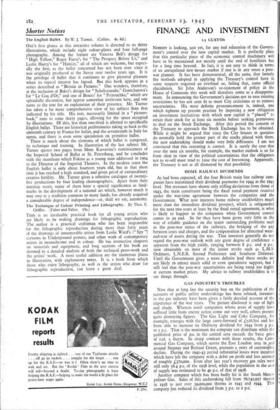The English Ballet. By W. J. Turner. (Collins. 4s. 6d.)
Shorter Notices
ONE'S first glance at this attractive volume is directed to its thirty illustrations, which include eight colour-plates and four full-page photographs. Among the former are Vanessa Bell's design for "High Yellow," Roger Furse's for "The Prospect Before Us," and Leslie Hurry's for " Ham:et," all of which are welcome, but especi- ally the first, as the ballet concerned has not been seen since it was originally produced at the Savoy over twelve years ago. It is the privilege of ballet that it continues to give pictorial pleasure when its topical interest has lapsed. But this book appears in a series described as "Britain in Pictures." One wonders, therefcre, at the inclusion of Bakst's design for " Scheherazade," Gontcharova's for "Le Coq d'Or," and one of I3enois' for " Petrouchka," which are splendidly decorative, but appear somewhat irrelevant here, and one turns to the text for an explanation of their presence. Mr. Turner has taken a far more comprehensive view of his subject than that indicated by his title. His text, necessarily limited in a "picture- book," runs to some thirty pages, allowing for the space occupied by illustrations. Of this, less than one-third is allotted to specifically English ballet. There are historical preliminaries taking us back to the sixteenth century in France for ballet, and the seventeenth in Italy for opera, and there is even some speculation on primitive ballet.
There is much about the elements of which ballet is composed, its technique and training. In illustration of the last subject Mr. Turner quotes two pages from Mme. Karsavina's reminiscences of the Imperial School of Ballet at St. Petersburg, and he concludes with the manifesto which Fokine as a young man addressed in 1904 to the Director of the Imperial Theatres. In the modern sense the English ballet is only about fourteen years old, but in that short time it has reached a high standard, and given prcof of extraordinary creative fertility. Mr. Turner gives a selective catalogue of twenty- five productions by four leading choreographers. Apart from their intrinsic merit, many of them have a special significance as land- marks in the development of a national art which, however much it may owe to a tradition common to many lands, has already acquired a considerable degree of independence—or, shall we say, autonomy. The Technique of Colour Printing and Lithography. By Thos. E.
Griffits. (Faber and Faber. 15s.)
THIS is an invaluable practical book for all young artists who are likely to be making drawings for lithographic reproduction. The author is a practical craftsman who has been responsible for the lithographic reproduction during more than forty years of the drawings of innumerable artists from Leslie Ward's (" Spy ") cartoons to Underground posters, and other work of contemporary artists in monochrome and in colour. He has instructive chapters on materials and equipment, and long sections of his book are devoted to a detailed analysis of both the technical press-work and the artists' work. A most -useful addition are the ninnerotis Plates in illustration, with explanatory notes. It is a book from which those who enjoy lithography, as well as the artists who draw for lithographic reproduction, can learn a great deal.


























 Previous page
Previous page